Here are two brand new diesel luxury sedans, each claiming to offer an engaging drive while also promising all the other luxury car benefits. So, which one walks the talk better?
Even though the XE and A4 arrived on the same day at our office for this comparison, I was quick to snatch the keys of the Jag before anyone else got the chance to jump into the driver’s seat. And that kind of explains half the story here. From what we learnt during our 11th-anniversary track test, the XE is a car that has a tendency to spoil its driver with its playful character. On top of that, it has a classier look – to my eyes at least – as compared to the A4. That long hood, sleek headlamps and flowing bodywork give it a look that’s befitting of its sports sedan tag. That said, I do have some reservations regarding its rear section – the tail-lamps are too big while the trunk is quite narrow and both elements don’t gel as well as they should. Also, the 17-inch wheels that are shod with high profile rubber is another mismatch. Still, the XE is a looker.
And things inside the cabin are pretty good too. You sit low in the XE with all the leather upholstery around you, making you feel very special indeed. One can’t help but notice that the two-pod analogue gauges are a straight lift from the F-Type and look quite sporty. What’s more, in Dynamic mode, they light up a fiery red. Another thing that caught my eye was the steering wheel – this three-spoke wheel not only provides a fair bit of feedback to the driver but can also be electrically adjusted for reach and rake – unlike Audi’s manual setup. Not that you would need to adjust the steering column often, mind you – but, still, it’s a nice feature to have in a 40-plus-lakh car!
The devil (that’s lacking) in the details
The Jag comes with an 8-inch touchscreen infotainment system, which is fairly easy to get the hang of. It works well most of the time, but sometimes there is a lag to your inputs. For instance, when paired with your Smartphone, the media player gets confused once in a while. And while the display is nice, the interface has bright coloured and loud graphics that remind you of those Nokia/Symbian phones from years ago – and, again, inside an elegant and lovely Jag it feels a bit out of place. The 380W Meridian sound system works flawlessly though, with sound quality that’s simply amazing.
When you’re fiddling with the toys inside the cabin, you also realize that Jaguar has used hard plastics on many surfaces. The buttons, in particular, have this tacky feel when you press them – they’re not flimsy, but they don’t feel like they’re built to last. On the upside, the rotary gear selector is still the coolest feature in the cabin.
All the aforementioned niggles can be neglected, however, if a car drives well. And that’s exactly what I had in mind when I left office in the XE. But, then it didn’t turn to be as enjoyable as I was expecting. Now before you think I’m being overly critical of the Jag, allow me to explain. You see, the XE has a few problems in traffic-infested areas. First, the visibility is hampered, thanks to the thick A-pillar and the car feels wider than it actually is. And while you can manage to get around that problem, there’s no getting away from that drivetrain...
The Jaguar XE was launched only with a petrol engine in India. But, despite the repeated hue and cry from the green brigade, diesel still remains the preferred fuel in the luxury segment. As a result, Jaguar added the Ingenium diesel engine to the XE range a couple of months ago (and subsequently discontinued the absolutely delightful petrol). The specifications are quite mainstream – 2.0-litre, inline-four turbo-diesel developing 177bhp and 430Nm of torque. Power goes to the rear wheels via a ZF sourced eight-speed automatic gearbox.
Out on the open road, the combination of the engine and transmission is excellent to say the least. As the revs cross the 2,000rpm threshold, the motor really delivers all of its poke. The 8-speeder plays along quite nicely, too – it’s super smooth and upshifts are quick. If you like pedal-to-the-metal sort of driving, the Ingenium motor doesn’t disappoint. However, if you find yourself stuck in traffic, things start going downhill.
First, the engine is still quite audible at low revs. Then comes the gearbox – whether you’re in regular D or the more aggressive S mode, it never seems to do its job at low speeds. There are, of course, settings to get around this problem. There are six modes to choose from – Normal, Eco, Dynamic, Rain, Ice and Snow – the last two are not really meant for our driving conditions. Irrespective of the mode you put it in, the engine response is more or less unchanged. Besides, the transmission always likes to stay in a higher gear than you’d like. So, when setting off from a standstill, it quickly goes into second gear – resulting in a lot of lag and quite slow progress. Not only that, the engine has a strange low-speed drone that can be quite annoying.
But this is not all, as there are other occasions where you can catch the automatic gearbox napping as well. When you’re doing speeds of, say, 100-120km/h and suddenly a car moves into your lane – forcing you to slow down – the gearbox doesn’t want to downshift. It stays in 8th gear, trying to save every drop of fuel it can. And since the power band is quite narrow – the peak torque of 430Nm is available only from 1,750-2,500rpm, so you don’t really get the push you want at high rpm. As a result, you really have to step on the throttle to let the gearbox know what you want – following which it does kick-down quite quickly, and then you’re back in business. You could also use the paddle-shifters to downshift in such a case, which I think is a more efficient and enjoyable way to handle this questionable engine tuning.
Stress-free motoring...
Driving the Audi in traffic, on the other hand, is rather enjoyable and stress-free thanks to its superior drivetrain. The A4 35TDI that you see here is powered by a 2.0-litre inline-four turbo-diesel that develops 188bhp and 400Nm of torque – 11bhp more, but 30Nm less than the Jag. However, what really makes this powertrain a brisk performer is its 7-speed dual-clutch transmission. Although the peak torque starts coming in at 1,750rpm, it stays for a longer duration all the way up to 3,000rpm. As we’ve seen with many VAG (Volkswagen Group) cars, the DSG transmission is super quick and functions as though it reads your mind. The upshifts are quick and part throttle inputs don’t confuse the tranny. The downshifts are timed well, too. Unlike the Jag, the Audi quickly drops gears as you drop speed. In really slow moving traffic though, it can get a bit jerky as the gearbox fiddles to find the right gear.
The best thing about the Audi is its super quiet cabin. Despite being powered by a diesel engine, there’s absolutely no noise or clatter that filters into the cabin. You can redline the engine all you want, but you hardly become aware of it. And then, when you glance through the cabin, the A4 simply beats the XE in every aspect. The quality of materials is top-class, and the fit-and-finish is even better. The features and equipment on the inside only wow you even more. The 8.3-inch MMI infotainment screen may not be touch operated, but it’s intuitive and crisp to use. Then there’s the A4’s real party piece – the Virtual Cockpit readout. The 12.3-inch digital screen that sits behind the steering wheel is a touch of genius. At the press of a button, it goes from showing the speedometer to 3D maps. This thing is really cutting edge, and you get hooked on it once you get used to all its functionality.
The A4 also scores big in terms of interior space and practicality. The rear bench can seat three passengers comfortably, and the boot is large with a flat opening. The seats, however, feel a bit hard in comparison to the XE’s. It’s a comfortable car to be driven around in though. The ride is supple, and it simply glides over all the road undulations. That said, hitting sharp potholes unsettles the car, and at low speeds, it can be a bit uncomfortable for passengers.
The handling of the A4 is a pleasant surprise. You see, as compared to the old A4, the new one is based on VW Group’s MLBevo platform that reduces its weight by over 100 kilograms. And that’s clearly evident in its handling. The A4 no longer feels uninspiring to drive – the front-end is more communicative than ever, and despite being a front-wheel-drive car, this car really grips well. Also, Audi Drive Select is now standard in the A4, meaning you have four driving modes to choose from – Comfort, Auto, Dynamic and Individual. Depending on the mode you select, the system alters the throttle response, steering feedback and gearshift characteristics. In the Individual mode, you can manually set the throttle, steering or transmission to the way you want them to behave. For instance, I liked the steering in Comfort mode, for it’s light and direct in this setting as opposed to being artificially stiff in Dynamic mode. I kept the engine and gearbox in Dynamic mode though.
Overall, the A4 is still not an out-and-out driver’s car, however, it’s a lot more exciting to drive than its predecessor ever was. Thanks to the light chassis, direct steering and super responsive powertrain, the A4 has finally got some attitude in the way it drives. In fact, driving the A4 in the city is more rewarding. The light controls and great visibility make it an easy car to live with.
Jag claws its way back…
On the contrary, the XE is not an easy car to drive on an everyday basis. Even though the steering has five settings, it always feels a little stiff – quite like a hydraulic unit. But, in a way, that’s a good thing. The feedback from the wheel is simply superb, and no matter how direct the A4’s steering is, it simply can’t match the XE on this front. Yes, at parking speeds, you do wish it had a little more assistance – but, on the whole, it’s a delight.
And, fortunately, I’ve driven the XE at the track – so I know exactly how communicative and sharp this car really is. And it’s not just the steering, the aluminium chassis and F-Type derived suspension setup make the XE a hoot to drive. When you drive the XE fast around a set of bends, you realize the sheer adjustability of its chassis. The front-end just sticks, while the rear tends to lose grip in a very, very progressive (and enjoyable) manner. Even an average driver can oversteer this baby Jag like a pro. I mean, during our last track test, we just kept fooling around with the Jaguar twins – the XE and XF – and it was unparalleled joy! There used to be a time when the BMW 3 Series was the perennial benchmark for handling in this segment, but it’s been dethroned by the XE.
Another impressive aspect of the XE is its ride quality. Despite being such a taut handler, the XE’s ride is unbelievably comfortable. In fact, it’s better than the A4 as the suspension soaks up any and all undulations. Having said that, when you go over bumps, there is some suspension noise that’s audible inside the cabin – but, you never feel any jolts.
Verdict
Even though I’m totally smitten by the XE’s dynamic capabilities, I would still think long and hard before writing a cheque to a Jaguar dealer. It’s a great tool to let your inner child lose, but you need open roads or a racetrack to exploit its full potential. Driving in the closed confines of a city makes it feel cumbersome and clumsy. Plus, the XE has other flaws that can’t be ignored – the legroom at the back is dismal, as it has less space than some sub-four-metre sedans. The quality, fit-and-finish and features inside the cabin are acceptable, but they’re nowhere near as good as the Audi.
All told, I know that the Jaguar will plaster a wider grin on my face with its brilliant chassis and rear-wheel drive, but it needs a specific setting (or set of roads more specifically) on which to do that. On a day-to-day basis, I’ll definitely be happier driving the A4 with its cutting-edge gadgets, superior interior, refined performance and balanced dynamics.
- Jaguar XE 20d
- Audi A4 35TDI
Engine: 1,999cc/ Inline-4 Cylinders/ Turbocharged
Fuel: Diesel
Transmission: 8-Speed Automatic / Rear-wheel Drive
Power: 177bhp @ 4,000rpm
Torque: 430Nm @ 1,750 – 2,500rpm
Price: Rs 44.72 lakh (ex-showroom, Delhi)
X-Factor: The XE sets new benchmark in ride and handling balance - it's now the most involving car to drive in the segment.
Engine: 1,968cc/ Inline-4 Cylinders/ Turbocharged
Fuel: Diesel
Transmission: 7-Speed dual-clutch automatic / Front-wheel Drive
Power: 188bhp @ 3,800 – 4,000rpm
Torque: 400Nm @ 1,750 – 3,000rpm
Price: Rs 42.66 lakh (ex-showroom, Delhi)
X-Factor: Cutting-edge technology, super responsive drivetrain and balanced drive dynamics make the A4 a perfect everyday luxury car.













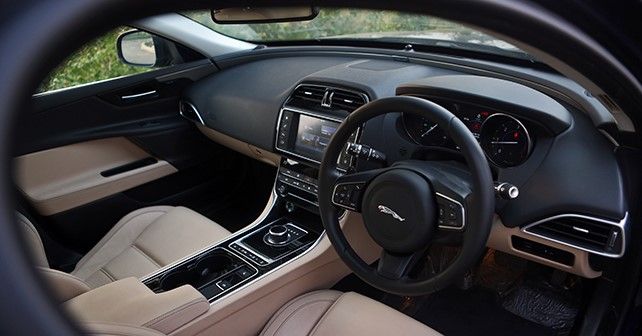
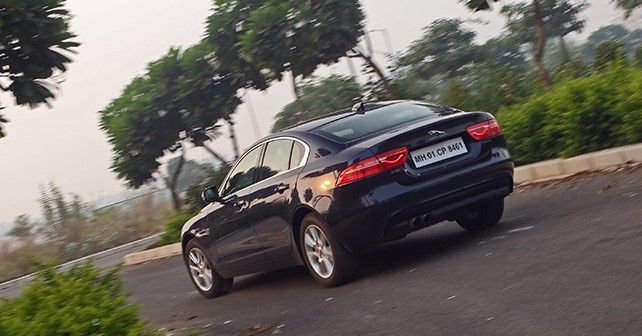



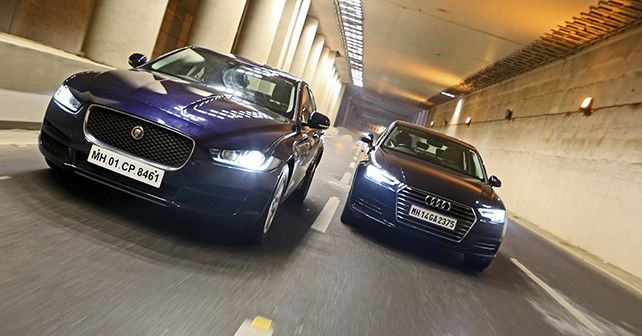
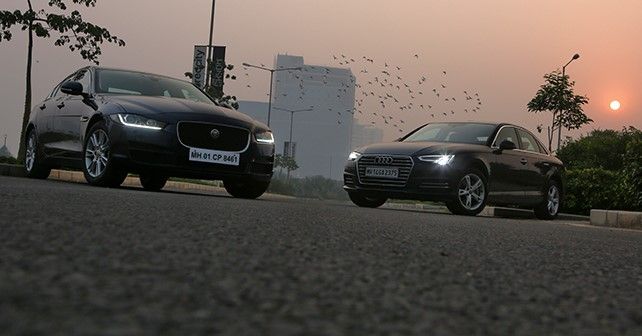





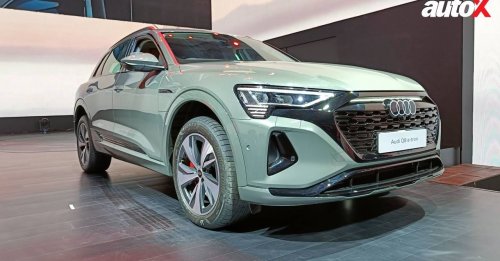














Write your Comment